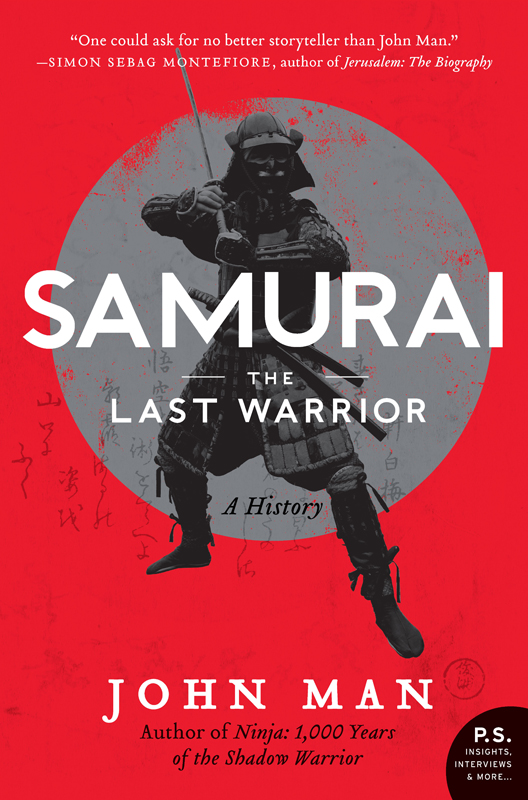
Samurai
A History
کتاب های مرتبط
- اطلاعات
- نقد و بررسی
- دیدگاه کاربران
نقد و بررسی

November 4, 2013
British historian Man (Ninja) adds to his solid series of general-audience books on Far East military subjects with this analysis of Japan’s military nobility. Taking an unusual perspective, he focuses on Saigo Takamori, whose iconic status as a 19th-century embodiment of the samurai ideal gave him “semidivinity... even before his death.” Man perceptively describes “samurai” as a sense of being: a way of the warrior built around the cult of the sword; seppuku, ritual suicide, as the ultimate proof of loyalty; and bushido, “freedom that is bound to service,” as the highest ideal. Renewing their identity to fit new circumstances, the samurai became “the very essence of Japanese society.” Saigo’s lord, Shuzami Nariakara, saw him as honest and trustworthy, fearing neither authority nor evil, and “the kind of man who cannot be manipulated.” Saigo became a key figure in the Meiji Restoration, but his conviction that “the duty of government is to serve the people” led him to reject the new Japan’s “politicians, bureaucrats, and capitalists.” Seeking the life of a “Confucian gentleman-scholar,” he resigned his offices. Drawn unwillingly into leading a doomed rebellion, he committed seppuku; in death he became “a national treasure” whose life and death embodied “the self-destructive courage, the nobility of failure, that was so much a part of the Japanese character.”

January 15, 2014
Man, a crack biographer of Asian historical figures (Ninja: 1,000 Years of the Shadow Warriors, 2012, etc.), tenders a survey of the samurai, the equivalent of Japan's feudal knights. This is a well-written piece of history with an easy storyteller's rhythm and plenty of intrigue. Readers will quickly realize that the author, who previously worked for Reuters and Time-Life Books, is well-versed in Far Eastern history, but he also accommodates new discoveries and insights. To understand the samurai, it is critical to understand the nature of the Japanese political landscape, "a patchwork of sixty provinces and six hundred estates, all scrapping with one another." The lords found protection in landowning warriors--samurai--who were gifted land by the lord and gathered wartime booty. There also arose a strict code of conduct within the samurais' elite community. They were generous, stoic, intelligent, and masters at swordplay and spiritual matters; they also realized that there was often no way out but death, which tended to make them rather fearless. But times change, and Mann intricately describes the shift in the orientation of the Japanese government after the post-1600 revolution: the rise of the shogun and the banning of warfare. In these peaceful years, the samurai could have disappeared, but they survived. "The key to their survival," writes the author, "was the way they renewed their sense of identity, not by abandoning the past but by cherry-picking aspects of it to suit new circumstances." The samurai became enforcers of the peace; they could kill at the drop of an insult, an act of adultery or out of revenge. But they were also schooled in the art of speaking and "of attitude, of clothing, of intellectual vigor"--a ready-made diplomatic corps. Smooth, sophisticated history writing.
COPYRIGHT(2014) Kirkus Reviews, ALL RIGHTS RESERVED.

January 1, 2014
Saigo Takamori (1828-77) was one of Japan's most colorful and complicated figures, famed in history, fiction, and legend as "the last samurai" for his roles in the Meiji Restoration and his leadership of the 1877 Satsuma Rebellion. Man (Ninja: 1000 Years of the Shadow Warrior; A New History) peppers his biography of Saigo with additional chapters on the samurai as a whole (with the expected discussion of bushido--the samurai honor code--and seppuku, a form of its ritual suicide) and on the development of the samurai's appeal in popular culture. As in his previous work, above, Man provides engaging accounts of Japanese culture, but again he is limited by a reliance on English-language resources. Some glaring mistakes, e.g., a photo of Tatsuya Nakadai in the film Harakiri is miscaptioned as Toshiro Mifune in Seven Samurai, undermine the book's credibility as a whole. VERDICT Despite errors, this is an entertaining read, though its appeal lies in its breezy style and its discussions of the modern-day popularity of samurai rather than in historical rigor. For that precision, see Mark Ravina's The Last Samurai, which remains the standard for an English-language biography of Saigo.--Kathleen McCallister, Univ. of South Carolina, Columbia, Libs.
Copyright 2014 Library Journal, LLC Used with permission.

February 1, 2014
For decades, Japanese and American literature and films have idealized and romanticized nineteenth-century samurai as a noble but anachronistic elite, doomed as Japan emerged from a feudal past. But British historian and Asian specialist Man has written an exciting, surprising, and moving account of the real thing. Saigo Takamori was born in 1817 into a family of relatively low-ranking samurai warriors. At the time, Japan was still governed as a decentralized state under the overall military authority of a shogun who ruled in the name of a largely ceremonial emperor. The samurai served as the shock troops for various local rulers, and sometimes for the shogun. In 1867, disgruntled samurai and some aristocratic families dissolved the shogunate and restored the power of the emperor. Whatever their intentions, the samurai had planted the seeds of their own destruction, as Japan modernized and evolved into a bureaucratic state. Takamori's continued devotion to the samurai traditions spelled his doom at the hands of powerful forces he helped to create. This is a well-written saga of an admirable warrior, who, like his class, fell victim to inevitable historical change.(Reprinted with permission of Booklist, copyright 2014, American Library Association.)

























دیدگاه کاربران